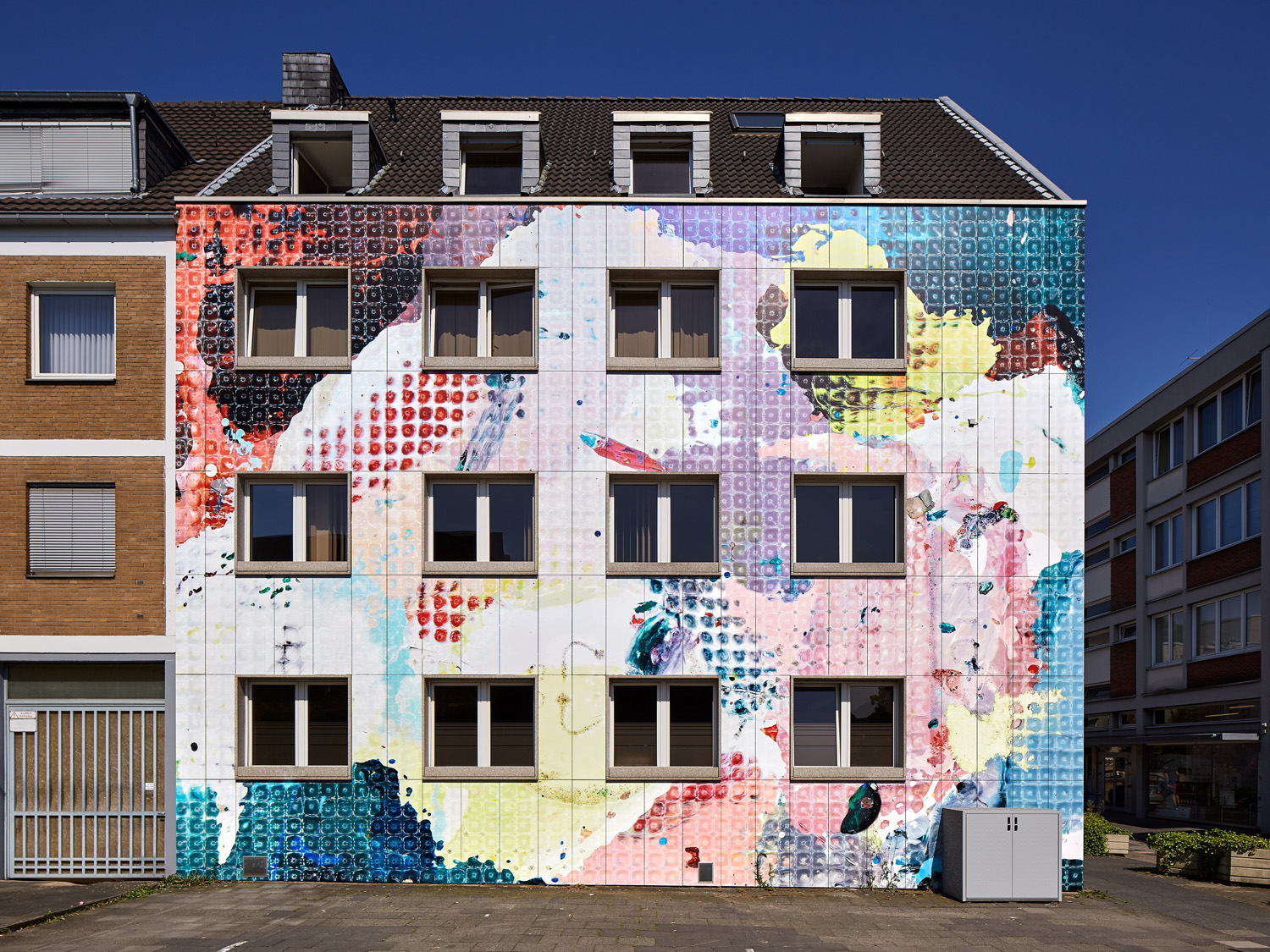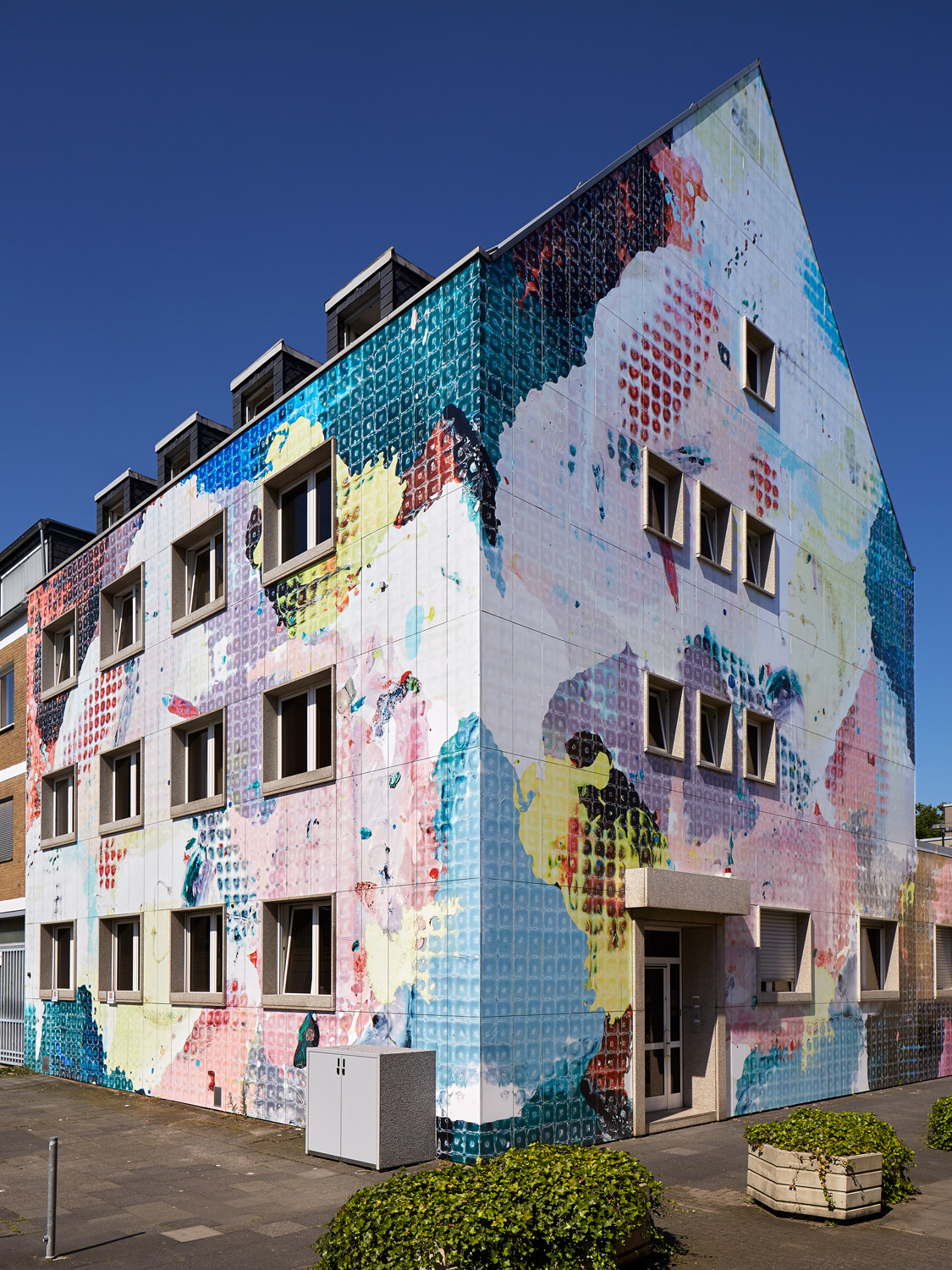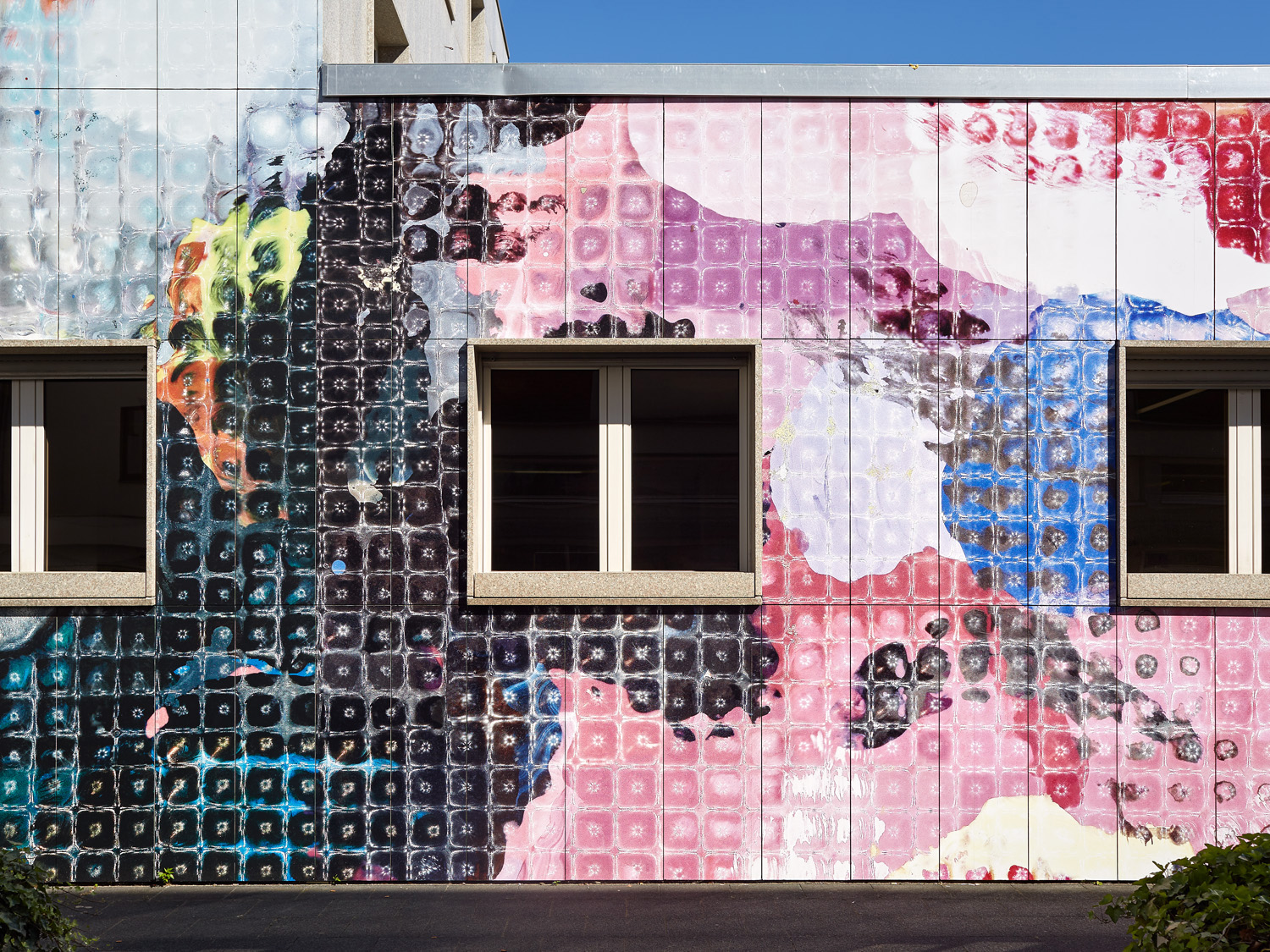
350cc (Haushaut), 2016
UV-Druck auf selbstklebender Folie / UV print on selfadhesive foil
13 x 30 x 17 m
Installation anlässlich der New Talents Biennale Cologne 2016 an der Hausfassade am Großen Griechenmarkt 2 in Köln / installation on the occasion of New Talents Biennale Cologne 2016 at Großer Griechenmarkt 2 in Cologne
Fotos: © Jonas Gerhard





(English below)
Gegen den Ruß – Ein Digital Mural in Köln
Von Dorothee Mosters
Jeden Morgen ist es dasselbe Spiel: vorbei an den mit Ruß und Feinstaub bedeckten Mehrfamilienhäusern, von A nach B.
Kölns Nachkriegsbauten haben nicht nur ästhetische Auswirkungen im Stadtbild, sie prägen auch den geistigen Zustand ihrer Bewohner. Gegen die Monotonie eines gräulich eigenschaftslosen Steinparcours wirkt die Künstlerin Julia Gruner mit ihrer All-Over-Installation in der südlichen Altstadt. Inmitten eines gewöhnlichen Innenstadtgebiets irritiert sie mit einem Fremdkörper – sie gibt diesen unsäglich öden Bauten eine Zäsur. Die gesamte Hausfassade ist in eine Farbexplosion gekleidet. Schlagartig ändern sich die Aufmerksamkeit der Passanten und die Reflexion der Farben in nächster Nähe. Abwechslung, Facettenreichtum und Farbvielfalt sind Signale, die das Gehirn beanspruchen. Es entstehen Anreize, auf die die ausgelebte Architektur an diesem Ort sonst verzichtet.
Durch die rein äußerliche Veränderung des Hauskomplexes entsteht eine harte Trennung zu den angrenzenden Bauten. Dies führt uns buchstäblich die provisorischen gesellschaftlichen Abgrenzungen vor Augen die diese Art von Hausbau hervorruft. Julia Gruner plädiert mit ihrem Eingriff für einen Austausch und schafft einen einzigartigen Resonanzraum. Er evoziert einen Austausch zwischen Bewohner und Passant, zwischen links und rechts und zwischen Oberfläche und Raum.
Um das Motiv erfassen zu können, ist ein gewisser Abstand notwendig. Denn was auf den ersten Blick als flüchtige Farbschüttung auf Badkacheln aus den 1950er Jahren anmutet, ist tatsächlich der Foliendruck einer bombastisch aufgeblasenen Mikroskopaufnahme willkürlicher Farbmischungen in einer Pommesbuden-Plastikschale – ein gewöhnliches Malereiutensil. Dabei behält Julia Gruner den ursprünglichen Fassadencharakter des Hauses im Blick und reinszeniert lediglich seine Kachelverkleidung. Auf die ursprüngliche Neuverkleidung von 160 x 60 cm großen schmutzweißen Marmorplatten – vermutlich ein Verschönerungsversuch anno 1989 – setzt Julia Gruner die quadratische Allzweckkachel. Als Raster für eine architektonische Planung? Nein, eher als sentimentale Grundierung für ein undurchsichtiges und unglaublich dynamisches Farbenchaos.
Diese Intervention in das Kölner Stadtbild kann vieles sein: Fresko, Land-Art, Mural, Grafitti, Kunst am Bau oder eine Plakatwand. In jedem Fall ist es ein öffentliches Werk, das uns allen gehört und uns alle trifft.
---
Camouflaging the Rust: A Digital Mural in Cologne
By Dorothee Mosters
Every morning the same old, same old: getting from A-to-B past blocks of flats covered in rust and dust.
Cologne's postwar houses not only have aesthetic repercussions on the image of the city, they also have an impact on the mental state of their residents. It is this monotony of a grey featureless route of concrete that the artist Julia Gruner counteracts with her allover installation in the south part of the old city. In the midst of an ordinary inner-city district, she introduces an alien element as irritation. She provides a cesura for these unutterably bleak buildings. The entire house facade is clothed in an explosion of color. At a blow, the attention of the passers-by is attracted, and the reflection of the colors changes their immediate vicinity. Variation, diversity and multicoloring are signals that engage the mind. Stimulus is invoked which the well-worn architecture has doggedly kept shy of here.
Through the house's purely superficial refurbishment, a sharp separation to the neighboring buildings ensues. A situation that literally opens our eyes to the provisional social division that this kind of housing complex conjures. With her intervention in the facade, Julia Gruner pleads for a replacement and creates a unique sounding board. One that invokes an interchange between resident and passer-by, between left and right and between flat plane and space. To be able to take in the motif, a certain distance is necessary. For what at first glance looks like a fleeting discharge of color on bathroom tiles from the 1950s is actually a print on self-adhesive paper of a microscopic photo showing a bombastic blow-up of a random color mix in a plastic french fries tray, a painter's low-end utensil. Whereby Julia Gruner has kept the original character of the facade and simply restaged its sheath of tiles. Onto the former new sheath of 160 x 60 cm large dirty-white marble slabs – probably a cosmetic do-over from 1980 – Julia Gruner has set these square tiles. As a grid for an architectural project? No, more a sentimental ground coating for an opaque and incredibly dynamic chaos of color. This intervention into the urban picture of Cologne can be many things: fresco, land art, mural, graffiti, art on architecture or a poster wall. In any case it is a public work that belongs to, and concerns, all of us.